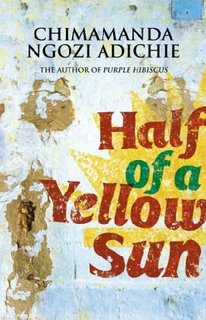Review: Half of a Yellow Sun
 We always seem to forget about Africa. Recent events have made this sin of omission painfully evident, and the unrest in Darfur is only one example of the West’s neglect.
We always seem to forget about Africa. Recent events have made this sin of omission painfully evident, and the unrest in Darfur is only one example of the West’s neglect. In our lifetime, we can recall the turmoil in Rwanda and Burundi, Somalia, and even the abolition of apartheid in South Africa. And as far as literature is concerned, our experience is even more limited. For most of us, any literary inquiry into Africa has consisted only of the Norton’s brief (yet expanded!) homage to “the rise and fall of empire”: Achebe and Coetzee. So it is at just the right moment that Chimamanda Ngozi Adichie has written her second novel, Half of a Yellow Sun, recalling an overlooked and brutal period in twentieth-century African history—the brief existence of the Republic of Biafra, an independent state that seceded from Nigeria in the 1960s.
Half of a Yellow Sun is a novel of awareness. Through the rotating perspectives of three main characters—Ugwu, a young villager who becomes a domestic servant for a revolutionary university professor; Olanna, the professor’s beautiful lover; and Richard, Olanna’s sister’s British lover—the reader comes to discover and understand the effects of national upheaval on the individual. Adichie’s sensitivity, cognizance, and understanding for her characters and their interiority are reminiscent of the masterful empathy of Graham Greene.
The characters are self-aware, and Adichie allows us glimpses into their thoughts, however frivolous they may be. One example, from Richard’s musings on Harrison, his servant, who has a penchant for sherry trifle and meringues: “He wondered, as he boarded the train, what it was Harrison did during the weekends. Perhaps he cooked himself tiny exquisite meals.” The characters’ awareness, however, can also be chillingly serious, particularly as Biafra unravels and the characters realize that the world will not come to their aid. Richard, as a white man and an outsider, is especially impacted by the neglect.
It was like somebody sprinkling pepper on his wound: Thousands of Biafrans were dead, and this man wanted to know if there was anything new about one dead white man. Richard would write about this, the rule of Western journalism: One hundred dead black people equal one dead white person. “There is nothing new to tell,” he said.
Because the characters generate the structure of Half of a Yellow Sun, they are necessarily the strongest aspect of the novel. The narrative depends entirely on the reader’s willingness to accept the authenticity of the characters, and Adichie ensures that this acceptance occurs. Her characters are credible, they are endearing, they are flawed.
It is of tantamount importance that Adichie establishes the fact that the characters are just like us. And so her book begins in a university town, in houses with books and brandy and heated discussions of desegregation in the American South. Parties are lavish, hotels have swimming pools, and Olanna drives a Peugeot. The transformation of the characters as the time passes from the early sixties into the late sixties, as Adichie divides her book, is striking. By the final chapters of the novel, the same characters who were eating canapés in manicured gardens are fighting each other for bits of roasted rat or lizard in refugee centers. Because Adichie has so carefully and thoroughly established the us-ness of her characters, she guarantees an appropriate response to their defeat.
The strongest underlying current in Half of a Yellow Sun is the belief each character holds in Biafra. Their faith is unwavering, even at the bleakest moments of the war. Adichie challenges her readers to comprehend such an intense belief in a political concept, in the birth of a nation-state. In the beginning, Biafra is a glorious model, a republic that will be a fair and just paragon of African states. The ideal of Biafra unites its people, as Olanna observes at a rally for the newly-formed state:
Olanna watched them and realized with a sweet surge that they all felt what she felt, what Odenigbo felt, as though it were liquid steel instead of blood that flowed through their veins, as though they could stand barefoot over red-hot embers.
At no point in the novel do the characters lose their conviction, and the steadfastness of their belief in Biafra becomes the tragic flaw for each of them. Only Ugwu, conscripted into the poorly trained army, gives any inkling of doubt about the reality of a triumphant Biafra.
It is dramatic irony, then, that drives home the novel’s pathos, as it becomes abundantly clear to the reader that Biafra cannot triumph, and the revolution is not led by intellectuals and diplomats, but by scrappy underage thugs. For the characters, a continued belief in Biafra is reduced to the hope that victory will at least give them food and shelter. The denouement is brutal; Adichie has prepared her reader to realize that it cannot be any other way.
The prescience of Adichie’s novel is that it provides, for our generation, a lesson in the consequences of ignorance, and a compelling argument against imperialism. While Half of a Yellow Sun imparts an important education about Nigeria in the 1960s, it provides as provocative a message about today’s conflicts in the Middle East.
Adichie’s novel could be a call to action, or perhaps only a warning—either way, it undeniably challenges our country’s and our generation’s disegard for human suffering across the globe.
Labels: The Fashionista


0 Comments:
Post a Comment
<< Home